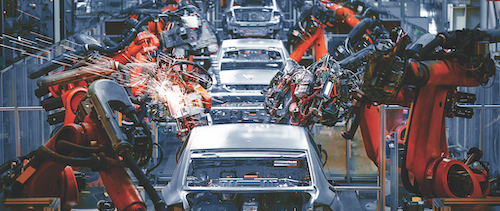The report, titled “How Robots Change the World” looks at several areas of the world, with the results demonstrating that the displacement of jobs will not be evenly distribute around the world or within countries, and that the negative effects of the robotisation of the world will be disproportionately felt in lower income regions of the globe’s major economies. Oxford Economics have put forward this research to help policymakers develop an early warning system to navigate the risks of automation.
Robot Surge
Industrial robots have led the way in installations of robots around the world, due to the repetitive and unvaried nature of the tasks they are performing. There has been a dramatic rise in global stock of industrial robots worldwide – having doubled since 2010 – and this is set to increase further in the next ten years. Due to previous investment and developement of technology, this growth is likely to be exponential, as better, more effective designs of robots are able to penetrate different markets and do tasks that are currently beyond their capabilities.
Where Japan used to be the world’s leader, it is now China that sets the pace, with approximately every third robot worldwide now being installed there. It also accounts for one fifth of the world’s stock of robots, up from 0.1% in 2000, and has expanded its lead as the world’s market of industrial robots, accounting for 36% of global sales, up from 30% in 2016. At this rate of growth, the number of industrial robots in China could be as many as 14 million by 2030. In comparison, though it has grown by 370,000 units since 2000, the relative combined inventory of the US and Europe has fallen to under 40% of the global share, where it used to be 50% at its peak in 2009. Japan has actually reduced its stock of robots by 100,000 since 2000, as its economy shifts away from manufacturing and it offshores production facilities, in places such as China.
Oxford Economics outline three trends responsible for the surge in robots worldwide. Number 1: robots are becoming cheaper than humans; with extended battery life and innovations in their processing power have made the robots better value, while labour costs are rising in major manufacturing economies, often due to ageing populations. Number 2: robots are rapidly becoming more capable; as the technology improves, they are being used in more sophisticated processes and can be installed quicker. Put simply, they’re easier to install and use in a variety of situations. Number 3: demand for manufactured goods is rising; China is central to this trend, as it has positioned itself as the global manufacturing leader and is investing heavily in robots to maintain it – China has become the world’s largest automotive manufacturing site, one of the main industries to utilise industrial robots.
Manufacturing robots
While China is the global leader in robot investment, it is not the only major manufacturing economy to rapidly expand its use of industrial robots in recent years. Oxford Economics quantified the impact of this global trend on manufacturing employment since 2000, and forecast the number of manufacturing jobs that could be lost to robotisation by 2030, but also the distribution of potential changes across regions of different incomes across the countries. The report notes that the fears of automation creating huge swathes of unemployment are misplaced, because the number of jobs and opportunities created will offset the jobs lost and overall productivity will increase, but this overall benefit of job creation will not be felt everywhere – different regions within countries will be affected in varied ways. Areas that are dependent on manufacturing jobs – cities and regions that have centres of manufacturing the power the local economies – will be the most affected by the introduction of new technology. This geographical imbalance has occurred throughout history when jobs and tasks have been automated.
The global effect calculated by Oxford Economics is that, since 2000, 1.7 million jobs globally are estimated to have been lost to robotisation, and with this current level of investment, by 2030 almost 20 million manufacturing jobs are expected to disappear due to automation. Furthermore, since 2004, for every one new industrial robot installed in the manufacturing sector, 1.6 human workers are displaced from their jobs. This is actually 1.3 in the first year, as the productivity gains from robotisation take time to materialise, as companies get to grips with their new technology and how best to implement it.
Manufacturing workers in lower income areas will be more vulnerable to automation due to having lower skill levels, with the average number of jobs lost to robots being 2.2 instead of 1.6, compared to 1.3 in higher-income regions. The report cites data from the UK Labour Force Survey to show that manufacturing workers in lower-income regions of the UK are more likely to work in lower-skilled occupations, with about 33% of the workforce in lower-income regions accounted for by elementary workers and machine operatives, compared with 22% in higher-income regions. This is a vulnerability that has developed over time, with cities in lower-income regions competing with the more expensive cities for manufacturing investment, creating lower cost of unit production through a lower paid and less productive workforce to carry out lower skilled jobs. The manufacturing workers in these regions will be at risk due to these jobs being easier to automate, and the regions will be affected as they will find it much more difficult to gain the benefits of automation – the “robotics dividend” – such as creation of new jobs from the overall productivity boost. Industrial automation will instead exacerbate the regional inequalities that exist in advanced economies.
Service robots
While the installation of industrial robots has already reduced the number of manufacturing jobs in advanced economies the world over, manufacturing only accounts for a small portion of total employment; instead, around three quarters work in the service sector. So far, the installation of physical robots – as opposed to software only applications – has been slow and service jobs have been difficult to automate, due to requiring a highly flexible way of working in an uncontrolled environment, an area in which robots are currently lacking. However, there is an acceleration in the uptake of service robots predict, particularly in logistics systems, with e-commerce companies such as Amazon driving innovation through their rapid expansion and use of new technologies.
The range of tasks and jobs in the service sector make predicting the job displacement from robotisation difficult, as there will be some that are relatively easy to automate – such as baggage handling at airports, a job that is already attracting robot investment – and there will be others that require uniquely human qualities, such as empathy, social intelligence, and cognitive skills that are difficult to translate into algorithms. While Amazon warehouse workers will be easy to replace with robots, bringing them into unstructured and uncontrolled environments is a different matter.
There are service areas that will be able to accommodate the installation of robots and find it cost-effective, usually on a larger scale. One example is of a hotel chain using a robot vacuum cleaner, where each floor has an identical floor plan or there are perhaps only two or three different plans throughout each hotel. This standardisation of environment allows for easier automation, as compared to a small B&B with only a few rooms, each with a different floor plan. So the service sector will not be immune to robotisation, especially when on a larger scale.
Responses and policies
Oxford Economics notes that historical evidence from the US labour market shows that manufacturing works tend to turn to service-sector employment when the production jobs disappear, mostly being absorbed into three categories: transport, construction and maintenance, and office and administration work. However, the research conducted by Oxford Economics suggests that these three categories may be among the most vulnerable to automation over the next decade, as the service sector is more easily penetrated by robots.
Retraining to other areas is still a valuable skill for workers to adopt as they face the prospect of automation, due to robot investment driving growth and creating new jobs across the market. The report recommends that workers learn to audit their own job to better understand the different skills involved – those that are uniquely human, and those that are easier to automate. In this way, the worker can learn to compete in the right area and future-proof their job against robotisation. There is also the need to adopt a “lifetime learning” mindset: in contrast to previous generations, there are few, if any, jobs for life anymore, so retraining and upskilling will simply become a normal part of employment.
For governments and policy-makers, the report recommends that the economic implications of robotisation are fully explored and analysed, so that policies can be adapted to the shifting landscape – flexibility is key. There is also the need to develop collaborative working environments, such as science parks, living labs, and other accessible innovation ecosystems to foster the development of skills for the smaller and medium-sized enterprises, so that they are not left behind. Most importantly, they need to identify the geographic areas that are most vulnerable to dislocation from the rise of robots and develop programmes to counteract those effects, looking at all options from infrastructure to training initiatives and innovative welfare programmes such as universal basic income.


.jpg)
.jpg)
.jpg)

.jpg)



.jpg)
